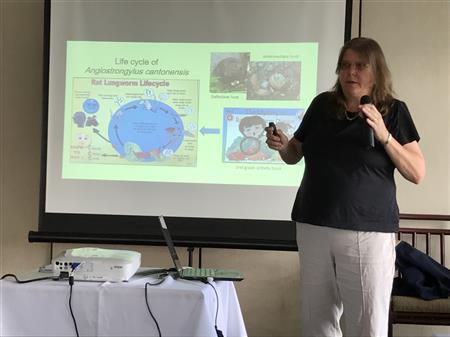With the pervasiveness of slugs and rats, we all face the risks of becoming infected by the rat lungworm disease (RLWD). Sue Jarvi, Ph.D., professor at the UH Hilo College of Pharmacy, founded the Hawaii Island Rat Lungworm Working Group in 2012. They have made considerable progress in promoting prevention of RLWD through education and outreach, research on infection levels in slugs and rats, exposure levels in humans, prevention through vaccination, and improvement in diagnosing the disease in humans.
The rat lungworm is a nematode with a complex lifecycle that requires two hosts-- the rat and slugs or snails. Adult lungworms live in rats. Baby lungworms exit the rats in feces. Slugs eat the rat feces. Lungworms grow and multiply in slugs. Humans and animals accidentally eat infected slugs. Larvae enter the body through the intestines where they then travel through the blood to the central nervous system. In most cases, symptoms occur within 2 weeks. Symptoms of intestinal inflammation include abdominal pain, nausea, diarrhea-- these symptoms are non-specific and often missed. Symptoms of the meninges inflammation include persistent severe headache, migrating nerve pain, sensory disturbances, speech difficulty, memory loss, paralysis. Brain inflammation (encephalitis) usually results in coma and death. Treatment includes steroids to reduce inflammation, anthelmintic drugs that kill parasites, and pain medications.
With the arrival of the semi-slug to Hawaii Island around 2004, the cases of RLWD has increased. Recent research has shown that semi-slugs are significantly more likely to be infected than the Cuban slugs. And the infestation of semi-slugs from Puna is significantly greater than Hilo. The larvae can survive for weeks in water; hence rain catchment systems are susceptible. Research has shown that the CDC-recommended 20 micron filter for water catchments is not sufficient. Further research is needed for an improved diagnostic method that is less invasive than a spinal tap, as well as to develop an effective vaccine.
Outreach education efforts have included a brochure for distribution at markets, a coloring book for second graders, and integrated pest management techniques at school gardens. Remember the 3 C's: check, Clean, Cook.


